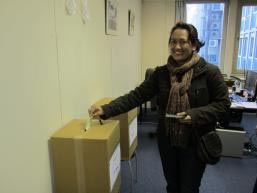
A voter casts a ballot in Brussels for the 2011 Kalon Tripa/Tibetan Parliament-in-Exile elections, held on March 20, 2011.
Over 82,000 exiled Tibetans across the world registered to vote in Sunday’s (March 20) election for Kalon Tripa (Chairman of the Cabinet), as well as 44 members of the parliament-in-exile. Eighty-six regional election officies in Asia, Europe, and the Americas are responsible for counting the votes and forwarding the results in secret to Dharamsala, the home of the Central Tibetan Administration (CTA). The Dharamsala-based Tibetan Election Commission will confirm and compile the voting results, which will be released on April 27. The new parliament may be in session in June-July, while the new Kalon Tripa should be in place by August. (Tibetan Election Commission).
The elections in India, Brussels, Zurich, New York and Toronto, were observed by a group from the International Parliamentarians for Tibet (INPaT). Members of ICT’s staff joined INPaT’s Tibetan Election Observation Mission (TEOM) in Zurich, Brussels and New York. Below are some of their observations:
Zurich, Switzerland
Kai Mueller, Executive Director, and Tenzin Samten Khangsar, of the International Campaign for Tibet supported the INPaT observer mission in Switzerland. The TEOM visited three polling stations where voting was observed: Rikon, Rapperswil-Jona and Zurich. Vote counting was also observed at the zurich station. At all polling stations, and during the counting process, the observer team was granted full access to the polling rooms, to officials and to voters. Kai Mueller, Executive Director of ICT-Germany, commented that, “the election process was conducted very professionally. It became apparent that the voters took the election very seriously and connected high expectations to the democratic process. Everyone seemed focused and proud of their elections.”
Brussels, Belgium
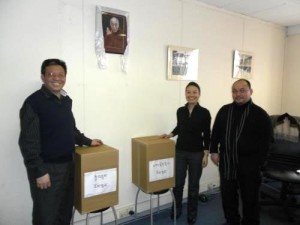
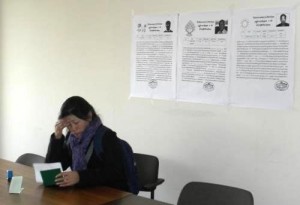 Biographies of the candidates hang in a voting location in Brussels. |
Tibetans in Belgium were eligible to vote in Brussels, Antwerp, Leuven and Ostende/Bruges, with polling stations open from 9am until 9pm. After voting was completed, the ballot boxes were taken to the Office of Tibet in Brussels, where they were counted on March 21 in the presence of two Tibetan observers and Ms. Kadri Vanem, Adviser to MEP Tunne Kelam on behalf of the TEOM. According to Office of Tibet Special Assistant to the Representative of H.H. the Dalai Lama, Ms. Genkhang Rigzin Choeden, 519 out of approximately 1000 Tibetans living in Belgium had registered to vote, including 104 out of 200 Tibetans living in Brussels.
Vincent Metten, EU Policy Director, and Paola Trevisan, Policy and Advocacy Officer, at ICT’s office in Brussels accompanied the INPat mission in Brussels. Following their visit, they offered the following description of the voting process:
When a voter enters into the office, he or she has to present their “green book” (a receipt book for voluntary taxes to the CTA). The staff than checks if the person is registered on the voting list. If not, they cannot vote. If they are on the list, the person has to sign the list and gets a “voted” stamp in their green book and then receives two documents, one green for the two parliament members in Europe they could vote for (out of four) and one white for the Kalon Tripa. Each document has a specific reference number and a picture of all the candidates. The voter then receives an explanation of the voting process by one of the three Tibetan staffers who stays at the polling station throughout the day. The voter then goes to another separate room to write their choice on the paper. In this room, seven posters with biographies of each candidate and their photo hung on the wall and could be consulted. The person then comes back and places each document in the appropriate box.
ICT found the three Tibetan staffers at the polling station to be “serious and professional,” and “very attentive to each voter,” noting that “rules and procedures seemed to be strictly followed.”
New York, New York, USA
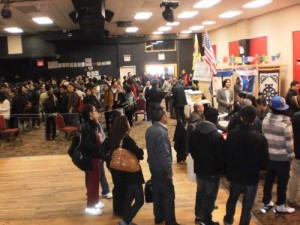 Tibetans line up to vote in New York City. 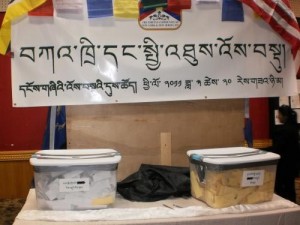 Sealed ballot boxes. 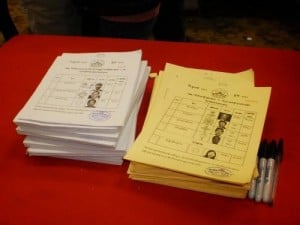 White ballots for Kalon Tripa, yellow ballots for Chitue (parliamentarians). |
Mary Beth Markey, ICT’s President, arrived at the Queens, New York polling station just before lunch on Sunday and found the overall atmosphere of the polling station as one of “excitement and patience.” “Hundreds were waiting in long lines that snake around the room back and forth five times, but despite the long wait, everyone seemed to be in very high spirits and taking the task at hand with all seriousness.”
The station served Tibetans living in New York, Connecticut and New Jersey, allowing many to reconnect with friends as they waited to vote. In all, approximately 2,200 Tibetans from the tri-state area were registered to vote.
While inside the polling station there were posters with candidate biographies and images, few people appearred to be reading them, as many said that they had already made up their minds. Election officials were on hand to answer any questions and to remind individuals of what to have prepared while waiting in line. They also stood by to keep children from peeking into the voting booths.
“Overall,” Markey noted, “the energy was positive and people were feeling good about participating in choosing their representatives.” She also added that the high turnout and long line “did not seem to dampen the voters’ excitement to vote.”

